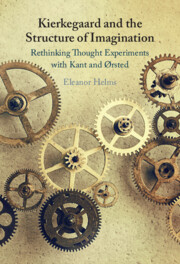Book contents
- Kierkegaard and the Structure of Imagination
- Kierkegaard and the Structure of Imagination
- Copyright page
- Contents
- Acknowledgments
- Abbreviations
- Introduction
- Part I The Origins of “Thought Experiment” in Kant and Ørsted
- Part II A Kantian Account of Thought Experiment
- Chapter 6 Varieties of Cognition
- Chapter 7 An Apparatus for Cognition
- Chapter 8 Cognizing Regulative Ideas
- Chapter 9 Bizarre Cases and Context
- Part III Kierkegaard and the Concept of Thought Experiment
- Conclusion
- Bibliography
- Index
Chapter 8 - Cognizing Regulative Ideas
from Part II - A Kantian Account of Thought Experiment
Published online by Cambridge University Press: 26 September 2025
- Kierkegaard and the Structure of Imagination
- Kierkegaard and the Structure of Imagination
- Copyright page
- Contents
- Acknowledgments
- Abbreviations
- Introduction
- Part I The Origins of “Thought Experiment” in Kant and Ørsted
- Part II A Kantian Account of Thought Experiment
- Chapter 6 Varieties of Cognition
- Chapter 7 An Apparatus for Cognition
- Chapter 8 Cognizing Regulative Ideas
- Chapter 9 Bizarre Cases and Context
- Part III Kierkegaard and the Concept of Thought Experiment
- Conclusion
- Bibliography
- Index
Summary
This chapter distinguishes the work of thought experiments in exemplifying concepts from their role in aiding cognition of regulative ideas. Contemporary interest in thought experiments as a “method of cases” treats thought experiments as providing instances or exemplars. For regulative ideas as Kant understands them, however, no observable instances or exemplars are possible. Nevertheless, thought experiments can direct attention toward regulative ideas negatively (by distinguishing them from what is observable) or positively by indicating a direction for extrapolation or ongoing inquiry. These positive uses are forms of cognition. The distinction between regulative and constitutive concepts matters for thought experiments that deal with regulative ideas such as the self – for example, for thought experiments about personal identity, where a number of objections to the use of thought experiments have been raised. I argue in this chapter that some of these objections can be answered by distinguishing regulative from constitutive concepts.
Keywords
Information
- Type
- Chapter
- Information
- Kierkegaard and the Structure of ImaginationRethinking Thought Experiments with Kant and Ørsted, pp. 119 - 137Publisher: Cambridge University PressPrint publication year: 2025
Accessibility standard: Inaccessible, or known limited accessibility
Why this information is here
This section outlines the accessibility features of this content - including support for screen readers, full keyboard navigation and high-contrast display options. This may not be relevant for you.Accessibility Information
Content Navigation
Allows you to navigate directly to chapters, sections, or non‐text items through a linked table of contents, reducing the need for extensive scrolling.
Provides an interactive index, letting you go straight to where a term or subject appears in the text without manual searching.
Reading Order & Textual Equivalents
You will encounter all content (including footnotes, captions, etc.) in a clear, sequential flow, making it easier to follow with assistive tools like screen readers.
You get more than just short alt text: you have comprehensive text equivalents, transcripts, captions, or audio descriptions for substantial non‐text content, which is especially helpful for complex visuals or multimedia.
Visual Accessibility
You will still understand key ideas or prompts without relying solely on colour, which is especially helpful if you have colour vision deficiencies.
You benefit from high‐contrast text, which improves legibility if you have low vision or if you are reading in less‐than‐ideal lighting conditions.
